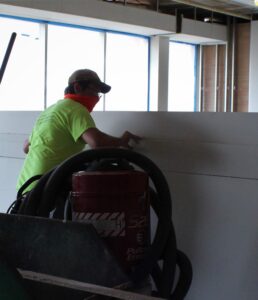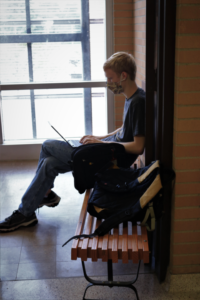
The L Building renovations were supposed to be completed before the start of the 2020 Fall Semester.
However, there have been significant delays in the completion of this project.
Jack Burns, director of Campus Planning and Facilities, said the COVID-19 pandemic was the primary cause of the delay.
“It’s made getting materials harder. There’s a lot of delays, because, just like us, a lot of factories were shut down. So now they’re trying to fill back-orders and new orders. Some things have gone up in price because there’s more of a demand, so it’s a ripple effect that works its way down,” Burns said.
Due to the delays in construction, the only spaces currently open to students are the lab classrooms.
According to Burns. Students taking classes primarily online rather than in-person allowed for more time to work out the logistics in terms of the construction timeline.
The goal is for these renovations to be completed by the Winter Semester of 2021.
When they are completed, the classrooms and lecture halls will have fresh coats of paint, new flooring, LED lights, updated audiovisual technology and different furniture.
The furniture will allow for greater flexibility in how professors are able to teach. Chairs and tables can be rearranged in order to have breakout sessions and group work, when previously, most tables and chairs were stationary.
“The lecture halls were really in need of an update, a refresh. With a new computer system and new projectors, I think it will really enhance what the professors can do in those rooms,” Burns said.
The changes will further standardize classrooms across campus.
The new design of these spaces was done with Kohler Architecture, a company in Monroe. The company was hired through a bidding process, wherein potential contractors held a mandatory walkthrough of the building, put prices together and had a formal opening. Ultimately, Kohler Architecture was hired because it offered the best services for the least amount of money.
Burns and Tracy Rayl, assistant professor of biology, both said several meetings were held between the architects and the faculty. These committees were held in order to come up with a design that would serve the needs of the students and faculty.
Burns’ role in the committee was to mediate the design group, keeping the discussions on topic and on schedule. Rayl’s role in these discussions was to bring up questions and concerns to the architects, and to represent the faculty point of view.
“Just from a practical perspective, it makes sense that you would have the people using those spaces involved in those decisions. As a faculty member, I have been very pleased and grateful that we have been asked to participate at that level,” Rayl said.
In addition, these spaces will be more accessible for people with disabilities in accordance with the Americans with Disabilities Act of 1990. Plus, there will be different types of seating available in order to suit the various needs of students, such as dedicated areas for wheelchairs.
Extensive work has been done to improve the safety in L Building. Rooms have been rewired to fix reoccurring electrical issues.

Hazardous materials have also been removed and replaced. Specifically, asbestos has been eliminated in areas of insulation at pipe joints and in the heating and cooling system.
In addition to the major renovations in progress in the lecture halls and classrooms, the laboratories have received updated lighting and more current audiovisual systems. Rayl took notice of these improvements as she facilitated her lab classes.
The ongoing construction impacted the lab schedule during the first week of the 2020. Rayl said the faculty who were teaching face-to-face labs had to rearrange when and where their classes were held.
Debris is often on the lab surfaces and materials, which requires extra cleaning. There is also some extra noise.
“Any time you do a construction project, there is going to be cleanup and noise associated. It’s understandable,” Rayl said.
Olivia Bruck, a student in the lab class Introduction to Environmental Science, said that the impacts have been minimal.
“It was slightly confusing when walking in, because there was a lot of workers and it felt like I wasn’t in the right building. It was modestly quiet and not too much noise. There was a slight breeze blowing that moved things slightly, but not bad,” Bruck said.
Both faculty and students look forward to the completion of this phase of L Building renovations.
“This is all positive and a good thing for us. We are all very excited to see the new lecture halls when we’re done. They have never been done to this extent. They’re gutting these rooms, so this is especially exciting for the faculty,” Rayl said.

